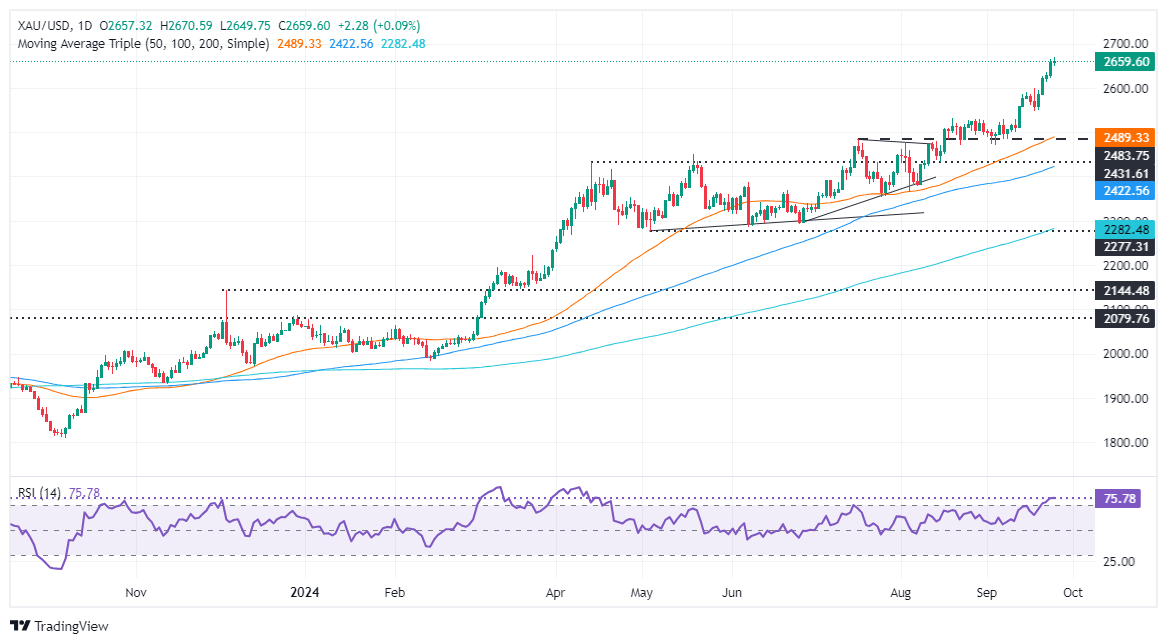Gold price retains $2,650 amid climbing US yields, strong USD
- Gold price steadied at $2,660 after hitting a record high of $2,670.
- Traders assign a 60% chance for another 50 bps of Fed rate cuts in November.
- US Treasury yields and a stronger US Dollar limited Gold's upside despite bullish momentum.

Gold price remains steadily above $2,650 for the second straight session on Wednesdayas traders increased the odds for another big interest rate cut by the Federal Reserve (Fed) at the upcoming November meeting. That and high US Treasury yields kept the XAU/USD from rising further, and it mostly traded near $2,660, up 0.14%.
Market sentiment shifted slightly sour during the US session as Wall Street traded in the red. Hence, Bullion prices hit a record high of $2,670 but retreated as US Treasury yields rose four and a half basis points (bps) to 3.775%.
In the meantime, the US Dollar Index (DXY), which tracks the buck’s value against another six currencies, bounced off a 14-month low and edged up 0.54% to 100.88.
During the week, US economic data showed that business activity in the manufacturing sector cooled while services remained resilient. However, a deterioration in Consumer Confidence via the Conference Board (CB) suggests that conditions in the labor market could be worse than projected.
Last week, the Fed lowered borrowing costs by 50 bps to 4.75%-5.00%, and traders seemed confident about back-to-back cuts of the same size. According to the CME FedWatch Tool, the odds for a 50 bps Fed cut are 60%, while 25 bps stands at 40%.
Bullion prices had risen 29% in 2024, sponsored by Gold’s physical demand and major central banks beginning their easing cycles. This and geopolitical tensions could keep traders setting their sights at $2,700.
Bullion has risen over 29% so far in 2024, with gains attributed to central bank easing and geopolitical issues.
Daily digest market movers: Gold price stays firm amid high US yields
- Gold price is capped by US Treasury bond yields.
- Tensions in the Middle East between Israel and Hezbollah underpin Gold prices.
- An uneventful US economic schedule on Wednesday left traders adrift to past data while they prepared for Fed Chair Jerome Powell's speech on Thursday.
- ETF flows, geopolitical tensions across the Middle East and China’s massive stimulus measures could drive Gold prices higher.
- According to the World Gold Council, global physically-backed Gold ETFs saw modest net inflows of 3 metric tons last week.
XAU/USD technical outlook: Gold price consolidates around $2,650-$2,660
Gold prices are set to extend the gains. However, price action turned sideways on Wednesday amid the lack of catalysts, which could push XAU/USD above its current record high toward $2,700.
From a momentum standpoint, the Relative Strength Index (RSI) signals that Gold is overbought, which could cause a leg-down before the rally resumes.
If XAU/USD extends its rally past the current year-to-date (YTD) peak of $2,670, look for a challenge of $2,675, followed by $2,700. Up next would be the $2,750 level, followed by $2,800.
On the flip side, if XAU/USD drops below $2,650, look for a test of the September 18 daily high at $2,600. The following key support levels to test will be the September 18 low of $2,546, followed by the 50-day Simple Moving Average (SMA) at $2,488.
Gold FAQs
Gold has played a key role in human’s history as it has been widely used as a store of value and medium of exchange. Currently, apart from its shine and usage for jewelry, the precious metal is widely seen as a safe-haven asset, meaning that it is considered a good investment during turbulent times. Gold is also widely seen as a hedge against inflation and against depreciating currencies as it doesn’t rely on any specific issuer or government.
Central banks are the biggest Gold holders. In their aim to support their currencies in turbulent times, central banks tend to diversify their reserves and buy Gold to improve the perceived strength of the economy and the currency. High Gold reserves can be a source of trust for a country’s solvency. Central banks added 1,136 tonnes of Gold worth around $70 billion to their reserves in 2022, according to data from the World Gold Council. This is the highest yearly purchase since records began. Central banks from emerging economies such as China, India and Turkey are quickly increasing their Gold reserves.
Gold has an inverse correlation with the US Dollar and US Treasuries, which are both major reserve and safe-haven assets. When the Dollar depreciates, Gold tends to rise, enabling investors and central banks to diversify their assets in turbulent times. Gold is also inversely correlated with risk assets. A rally in the stock market tends to weaken Gold price, while sell-offs in riskier markets tend to favor the precious metal.
The price can move due to a wide range of factors. Geopolitical instability or fears of a deep recession can quickly make Gold price escalate due to its safe-haven status. As a yield-less asset, Gold tends to rise with lower interest rates, while higher cost of money usually weighs down on the yellow metal. Still, most moves depend on how the US Dollar (USD) behaves as the asset is priced in dollars (XAU/USD). A strong Dollar tends to keep the price of Gold controlled, whereas a weaker Dollar is likely to push Gold prices up.
Author

Christian Borjon Valencia
FXStreet
Christian Borjon began his career as a retail trader in 2010, mainly focused on technical analysis and strategies around it. He started as a swing trader, as he used to work in another industry unrelated to the financial markets.


















